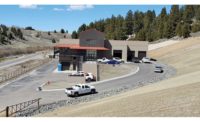Water/Environment, Best Project - Kandiyohi County Landfill Leachate Treatment System

PHOTO BY PAULA CHARCHENKO, COURTESY OF CLARK ENGINEERING

PHOTO BY PAULA CHARCHENKO, COURTESY OF CLARK ENGINEERING

PHOTO BY PAULA CHARCHENKO, COURTESY OF CLARK ENGINEERING

PHOTO BY PAULA CHARCHENKO, COURTESY OF CLARK ENGINEERING




Kandiyohi County Landfill Leachate Treatment System
New London, Minn.
Best Project
Owner Kandiyohi County, Minn.
Lead Design Firm Clark Engineering
Contractor Marcus Construction
Civil and Structural Engineer Clark Engineering
Financing and Bonding Apex Efficiency Solutions
Trucking more than 3 million gallons of toxic leachate from the Kandiyohi County Landfill on public Minnesota roads each year was problematic and expensive. The wastewater treatment plant that received the landfill’s discharge was not capable of treating some of the contaminants, so it would be diluted and discharged into local waterways and ultimately into the Mississippi River basin.
A demonstration and engineering parametric design study of a single-pass membrane system, called Leachbuster, led to a $2.8-million upgrade to the county landfill. Embraced by the Minnesota Pollution Control Agency for its use in Kandiyohi County, the patent-pending technology concentrates and treats the leachate waste products, returns the non-hazardous and inert products to the landfill and discharges the treated leachate to a sedimentation basin. The treated leachate produced through the process meets the Primary National Drinking Water Standard. The team claims the technology is the first of its kind to restore wastewater to drinking water via a single-pass membrane system without pre-treatment or chemical use.
The system treats contaminants and contains them within the landfill so they are no longer discharged into Minnesota waterways. The building that houses the leachate treatment is a reinforced CMU block design with a cast-in-place reinforced concrete foundation wall system. The building was constructed with design-build electrical and mechanical systems in order to provide more efficient and cost-effective project delivery.
The system is sized to accommodate projected leachate volumes at the landfill through 2034. The system is modular, allowing for expansion if future flows exceed current capacity.
Capital and operational costs are lower than the cost of the previous handling of leachate discharge over a 20-year life cycle. The team estimates that the system will not only pay for itself, but will also save the county nearly $3 million over that time. The carbon footprint of the new system is expected to reduce carbon emissions by at least 113 metric tons over 20 years of operation. In addition, installed equipment can be placed in “preservation mode” during periods of low flow to reduce energy consumption and other operating costs.







